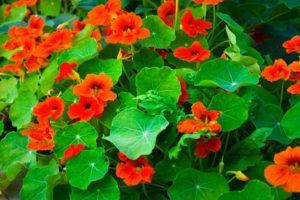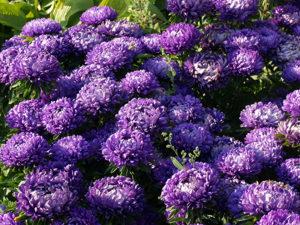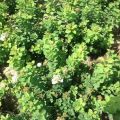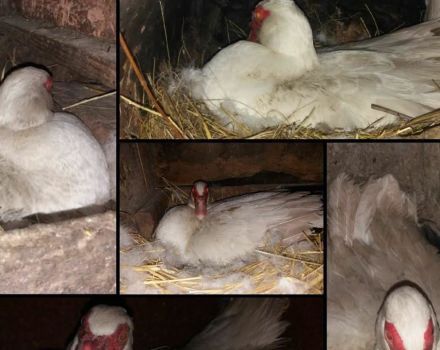Types and varieties of spirea with descriptions and characteristics, growing rules
Walking in the park in the warm season, you can see beautiful bushes with long flexible branches, densely covered with small flowers in inflorescences. This is a perennial shrub from the pink family - an ornamental spirea, which has about 90 species and varieties. The plant is very unpretentious, appreciated for its high decorative qualities, a long flowering period, and resistance to extreme weather conditions.
General information about the plant
Common spirea can be found in natural nature. The shrub feels comfortable in the temperate climate of steppes, forest-steppes, semi-deserts, as well as in northern latitudes. In Russia, it is bred as an ornamental plant to decorate parks, gardens and home gardens. The plant is also planted to strengthen the soil, since it has a well-branched root system.
Spirea is also a valuable medicinal plant. Some of its varieties are a source of essential oils, minerals, phytoncides, vitamin A and ascorbic acid.
Spirea is a deciduous shrub. Its height can vary from 15 centimeters to 2.5 meters. The plant is unpretentious to the quality of the soil, feels good in the polluted, gassed atmosphere of the city.
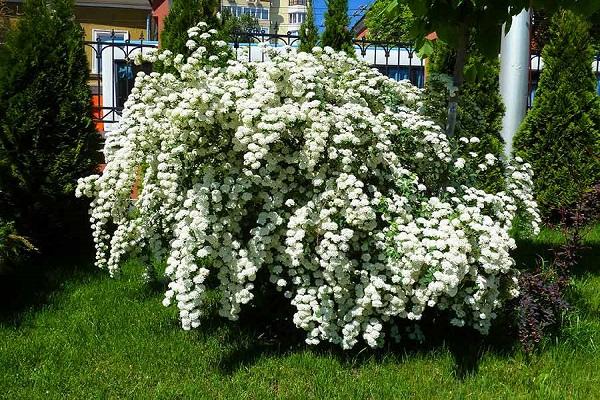
What colors can be?
Each type and variety of spirea has its own flowering time, and during this period it pleases the surrounding inflorescences with bright colors. The color range - from snow-white, pink, pale beige, to rich colors, including burgundy and lilac.
- Cultivars that bloom in the spring often have white inflorescences that cover the shoots along their entire length.
- All shades of red are inherent in summer flowers. At the same time, those blooming in early summer are often painted in a pale pink color, late blooming ones have burgundy or bright crimson shades.
The foliage of the spirea is no less beautiful than the inflorescences. In some species, it changes colors: red turns green with the onset of summer. Yellow or orange shades appear in autumn. There are varieties with bicolor leaves. The variegated spirea is very beautiful.
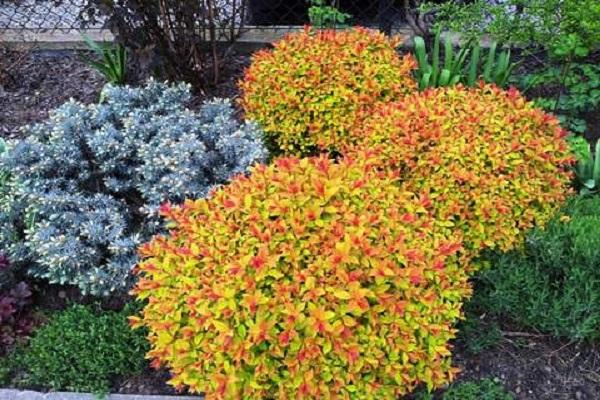
Varieties of spirea
The species and varieties of plants are also pleasing with a variety of forms. Depending on the location of the branches, the crown of the shrub can be pyramidal, weeping, erect, creeping, cascading, spherical.
According to the flowering time, all plants are divided into two large groups - spring flowering and summer flowering. They differ in the nature of flowering, in the type and shape of the inflorescences:
- Spring-flowering varieties bloom very amicably, but for a short time.Flowers bloom on last year's shoots.
- Summer blooming spireas bloom much longer. In this case, the newly appeared flowers are gradually replacing those that have already faded. Inflorescences appear on the shoots of this year.
The shape of the inflorescences is also not the same. It can be corymboid, spike-shaped, pyramidal and paniculate. There are also shrubs with single flowers. Inflorescences can cover the entire shoot, the upper part or the very end.
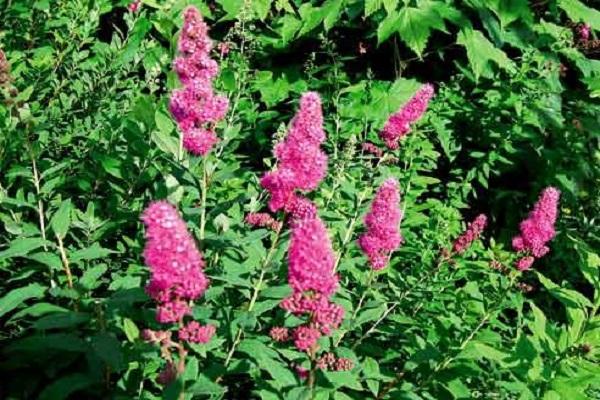
Billard
Billard's Spirea is a powerful bush reaching 2.5 meters in height. It grows throughout Russia, both in the southern and northern regions. The plant has a long flowering period, covering the entire warm period. It has straight, vertical stems, forming a lush spherical crown.
Billard's spirea blooms in large inflorescences, composed of 10-20 small flowers of rich pink color. The inflorescences are in the shape of a pyramid or candle.
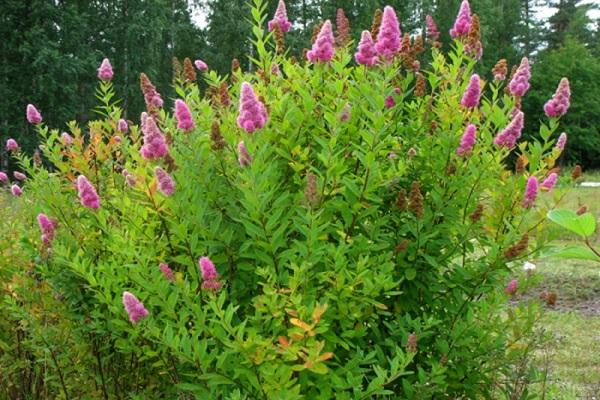
Average
Medium spirea is a shrub with a large crown formed by branches growing vertically upward. The natural habitat - forests and forest-steppe of Siberia, Central Asia and the Far East.
It belongs to the spring-flowering species, since it begins to bloom in mid-May. By early summer, flowering ends. The plant has corymbose inflorescences formed by groups of small white flowers. Due to the beautiful rounded crown, the bush is attractive even in the period when the flowering is already finished.
Paniculata
Spirea bushes paniculata can reach one and a half meters due to straight branches extended upwards. The beauty of the plant is given by the dense foliage of an emerald hue. The plant belongs to late flowering species. In the middle of summer, it blooms with bright pink flowers, collected in rather large inflorescences in the form of elongated fluffy panicles.
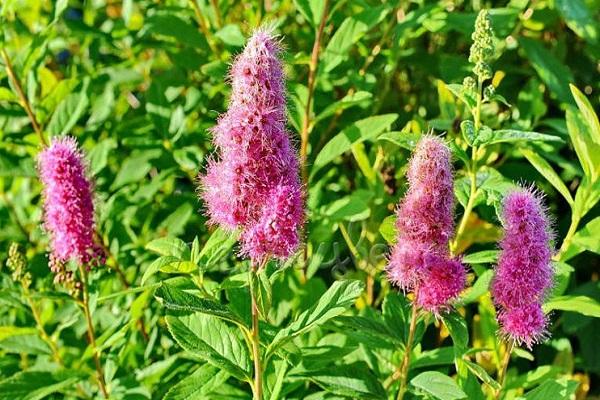
Little Princess
The plant got its name due to its small size - up to 60 centimeters in height. It is long-flowering - blooms all summer and half of autumn (until the end of October). Looks very picturesque as part of garden compositions.
The plant has a curly dense crown due to its deep green foliage. With the onset of autumn, the color turns orange, then red.
The bush blooms with corymbose pink inflorescences located at the ends of the branches. Fading inflorescences are gradually replaced by young ones. This ensures the duration of flowering. During the period of active flowering, foliage is not visible due to the large number of delicate inflorescences.
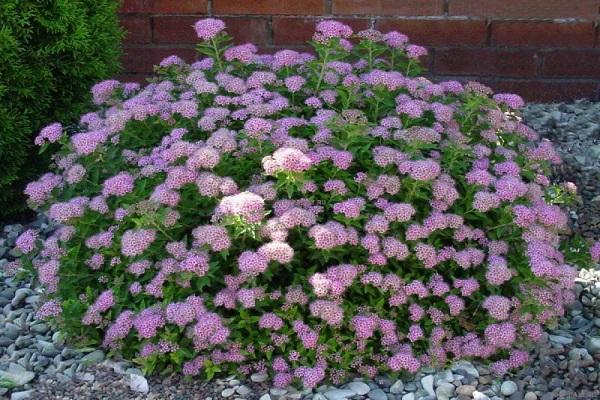
Willow
The shrub has elongated wedge-shaped foliage that resembles the crown of a weeping willow, although the branches are vertical. A dense mass of leaves forms a picturesque spherical crown.
The plant is hygrophilous, and grows rapidly under good conditions. It has a long flowering period - from the second half of June to mid-September. Small flowers form trapezoidal inflorescences at the ends of the branches in a rich pink or burgundy color.
Willow spirea is known in folk medicine as a medicinal plant. A decoction and tincture of leaves and branches are used as an anti-inflammatory, wound-healing, antipyretic, anthelmintic.
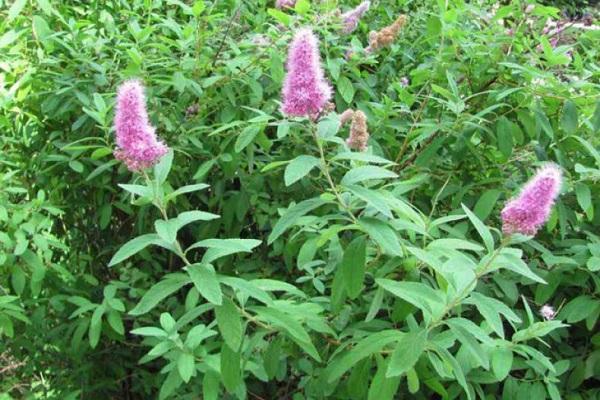
Wangutta
Spirea Vangutta is a good option for decorating adjoining territories and summer cottages. This shrub is informally called "May snow". At the time of flowering, long flexible branches are covered with snow-white flowers, which are collected in the cups of the inflorescences. Merging into one mass, they take the form of a snowdrift lying on the branches. Green foliage is practically not visible behind the "snow". Leaning under the weight of the inflorescences, the shoots give the bush the shape of a cascade.
Oakwood
Oak-leaved spirea is often used to equip park areas. The plant is unpretentious, feels good in low temperatures.
The shrub has a dense round crown. The plant is not long-flowering. Blooming in early May, by the end of the month it already loses flowers. It blooms with lush white inflorescences that completely cover the branches.
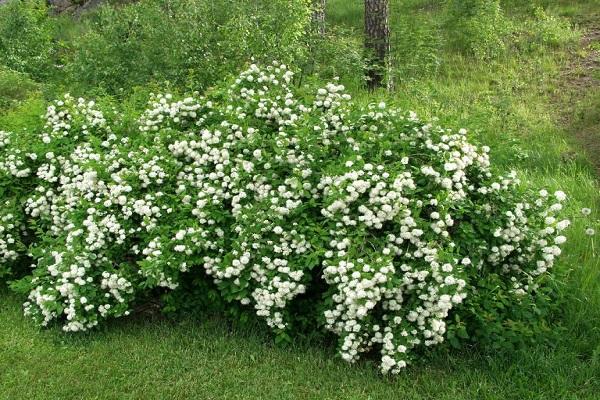
Nippon
The homeland of the Nippon spirea, as the name suggests, is Japan, or rather, the island of Shikoku. This is a tall shrub (up to 2 meters in height and more). It has a spreading crown formed by flexible branches. The foliage changes color from dark olive to green throughout the year, and then, in autumn, to red.
The plant belongs to early flowering varieties. It pleases the eye with flowering at the end of May, which lasts until August. White flowers are collected in corymbose inflorescences.
Thunberg
Low shrub with an openwork crown formed by graceful curving branches. The homeland of the plant is Korea, Japan and China. The plant is photophilous, refers to frost-resistant varieties, but freezes at very low temperatures. Does not require frequent watering.
Along with flowers, the decoration of Thunberg's spirea is thick leaves that change color from yellow in spring to green in summer heat. With the arrival of autumn cold weather, the plant becomes red-leaved.
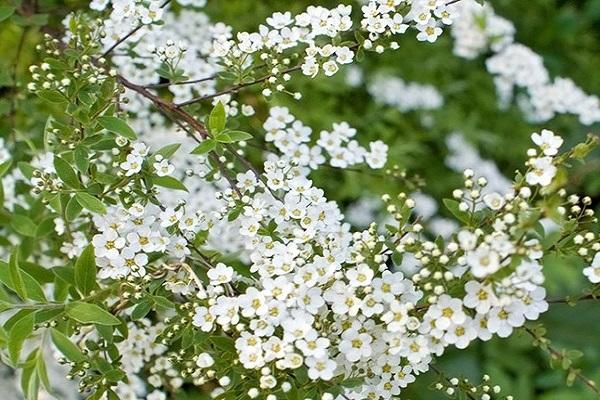
Gorodchaty
Spirea crenate in Russia is found in the steppes, as well as on the mountainous slopes of the Caucasus and Central Asia.
The shrub belongs to undersized varieties (it is no more than a meter in height). It got its name from the shape of the leaves - oblong, with a characteristic crenate edge. Shield inflorescences are yellowish flowers, up to five millimeters in diameter. It is a short-flowering species (blooms in June, no more than 15-20 days).
Plant selection criteria
All varieties of spirea are beautiful and picturesque all year round, regardless of whether the plant is blooming or not..
When choosing a type of plant for a summer cottage, they rely on the following criteria:
- Crown shape. Formed by graceful interweaving of branches. Bushes with lush crowns are best used as single plants. Planted in the composition, they will interfere with the growth of other plants.
- Flowering time. Plants that bloom earlier bloom for a short time, and late blooming plants delight with flowers until mid-autumn. Experienced gardeners, composing compositions, skillfully combine various types of shrubs. This achieves continuous flowering of spirea during a warm period of time.
- Deciduous cover. Many varieties of spirea have original leaves of unusual colors. The foliage color can change many times, depending on the season.
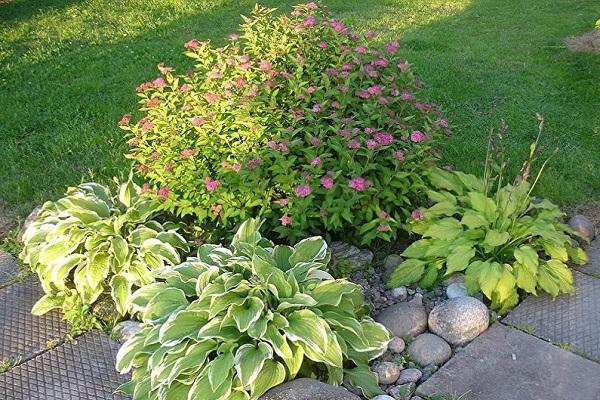
The use of spirea in landscape design
The shrub is popular for landscaping. It is often used as a single object. It is also suitable for creating compositions in combination with other plants. Mostly these are shrubs (lilac, viburnum, willow) or conifers (juniper, spruce, pine).
Spirea is used to create a hedge, mixborder or background for a flower garden. Dwarf varieties successfully frame paths or become an ornament for rockeries. Bushes are often planted in apiaries. Fragrant flowers are honey plants.
